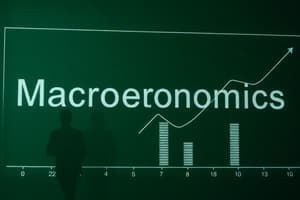Podcast
Questions and Answers
What does microeconomics primarily focus on?
What does microeconomics primarily focus on?
- National income and GDP
- Global trade and exchange rates
- Government regulations and policies
- Individual agents like consumers and firms (correct)
What is opportunity cost?
What is opportunity cost?
- The total cost incurred during production
- The expenses related to unemployment
- The monetary value of goods sold
- The cost of the next best alternative foregone (correct)
Which economic system emphasizes private ownership of production?
Which economic system emphasizes private ownership of production?
- Feudalism
- Communism
- Socialism
- Capitalism (correct)
What does GDP stand for?
What does GDP stand for?
What role does government play in regulating markets?
What role does government play in regulating markets?
Which economic theory argues for government intervention to stabilize the economy?
Which economic theory argues for government intervention to stabilize the economy?
What impacts international trade significantly?
What impacts international trade significantly?
What is a primary characteristic of a mixed economy?
What is a primary characteristic of a mixed economy?
Flashcards are hidden until you start studying
Study Notes
Definition of Economics
- Study of how individuals and societies allocate scarce resources.
- Involves decision-making regarding production, distribution, and consumption of goods and services.
Branches of Economics
-
Microeconomics
- Focuses on individual agents (consumers, firms).
- Analyzes supply and demand, market structures, and pricing.
-
Macroeconomics
- Examines the economy as a whole.
- Discusses national income, GDP, inflation, and unemployment.
Key Concepts
-
Scarcity
- Limited resources vs. unlimited wants.
-
Opportunity Cost
- The cost of the next best alternative foregone when making a decision.
-
Supply and Demand
- Supply: Quantity of a good/services producers are willing to sell.
- Demand: Quantity consumers are willing to buy.
- Equilibrium: Point where supply equals demand.
Economic Systems
-
Capitalism
- Private ownership of production.
- Market-driven economy.
-
Socialism
- Collective ownership or regulation of production.
- Emphasis on equal distribution of resources.
-
Mixed Economy
- Combination of capitalism and socialism.
- Both private and public sectors play a role.
Economic Indicators
-
Gross Domestic Product (GDP)
- Total value of all goods and services produced in a country.
-
Inflation Rate
- Rate at which the general level of prices for goods and services rises.
-
Unemployment Rate
- Percentage of the labor force that is jobless and actively seeking employment.
The Role of Government
- Regulation of markets to prevent monopolies.
- Provision of public goods (e.g., national defense, education).
- Fiscal policy: Government spending and tax policies to influence the economy.
- Monetary policy: Control of money supply and interest rates by central banks.
International Economics
-
Trade
- Exchange of goods and services between countries.
- Benefits include comparative advantage and economies of scale.
-
Exchange Rates
- Value of one currency in relation to another.
- Influences international trade and investment.
Economic Theories
-
Classical Economics
- Emphasizes free markets and the idea that markets are self-regulating.
-
Keynesian Economics
- Advocates for government intervention to manage economic cycles.
-
Supply-Side Economics
- Focuses on boosting supply through tax cuts and deregulation.
Conclusion
- Economics is a vast field with practical implications in everyday decision-making and public policy.
- Understanding its core concepts is essential for analyzing both individual choices and broader economic trends.
Definition of Economics
- Economics studies how individuals and societies allocate scarce resources.
- It involves decision-making regarding the production, distribution, and consumption of goods and services.
Branches of Economics
- Microeconomics
- Concentrates on individual agents like consumers and firms.
- Analyzes factors such as supply and demand, market structures, and pricing mechanisms.
- Macroeconomics
- Investigates the economy as a unified entity.
- Discusses important national metrics including national income, GDP, inflation, and unemployment rates.
Key Concepts
- Scarcity
- Represents the limited nature of resources compared to the unlimited human wants.
- Opportunity Cost
- Refers to the value of the next best alternative that is forgone when one choice is made over another.
- Supply and Demand
- Supply is the quantity of goods/services producers are willing to sell.
- Demand is the quantity consumers are ready to purchase.
- Equilibrium occurs when supply matches demand, stabilizing prices.
Economic Systems
- Capitalism
- Characterized by private ownership of production and a market-driven economy.
- Socialism
- Features collective ownership or regulation of production with a focus on equitable resource distribution.
- Mixed Economy
- Combines elements of capitalism and socialism, incorporating both private and public sector involvement.
Economic Indicators
- Gross Domestic Product (GDP)
- Represents the total value of all goods and services produced within a country during a specific period.
- Inflation Rate
- Indicates the rate at which the general price levels of goods and services rise over time.
- Unemployment Rate
- Shows the percentage of the labor force that is unemployed and actively seeking work.
The Role of Government
- Regulates markets to prevent monopolistic behaviors and ensure fair competition.
- Provides public goods such as national defense and education.
- Implements fiscal policy through government spending and taxation to influence economic performance.
- Executes monetary policy by managing money supply and interest rates through central banks.
International Economics
- Trade
- Involves the exchange of goods and services between nations, promoting benefits such as comparative advantage and economies of scale.
- Exchange Rates
- Defines the value of one currency relative to another, impacting international trade dynamics and investment flows.
Economic Theories
- Classical Economics
- Promotes the notion of free markets and asserts that markets tend to self-regulate.
- Keynesian Economics
- Proposes active government intervention to influence economic cycles and promote stability.
- Supply-Side Economics
- Focuses on enhancing supply through measures like tax reductions and deregulation to stimulate economic growth.
Conclusion
- Economics is a comprehensive discipline with significant implications for everyday choices and public policymaking.
- Grasping its fundamental concepts is vital for understanding individual decisions and broader economic trends.
Studying That Suits You
Use AI to generate personalized quizzes and flashcards to suit your learning preferences.




